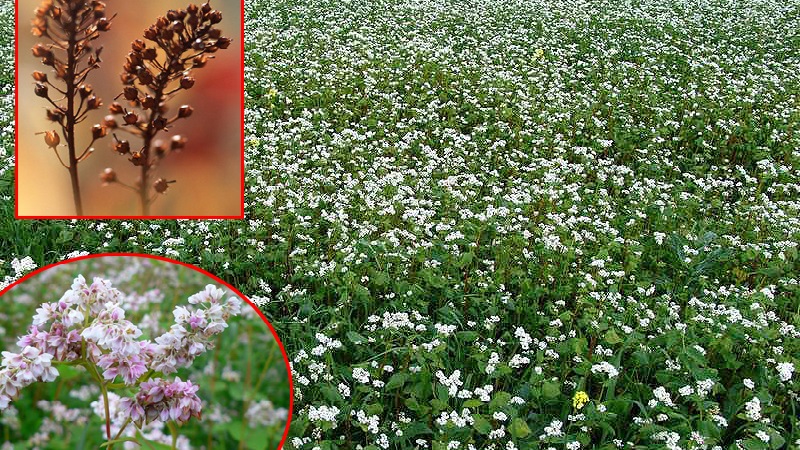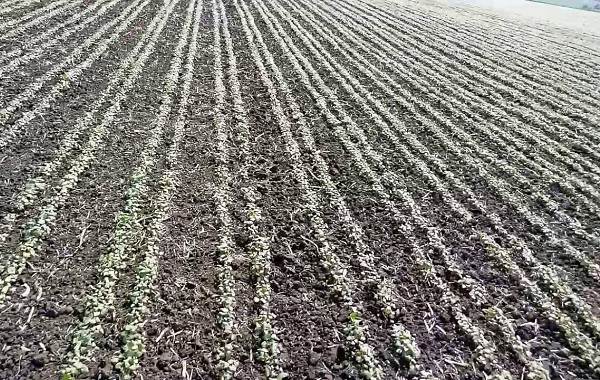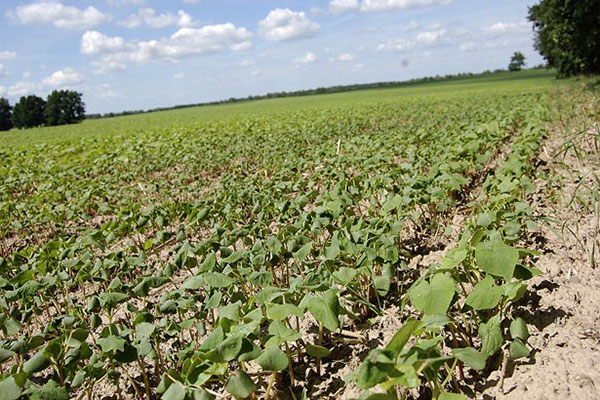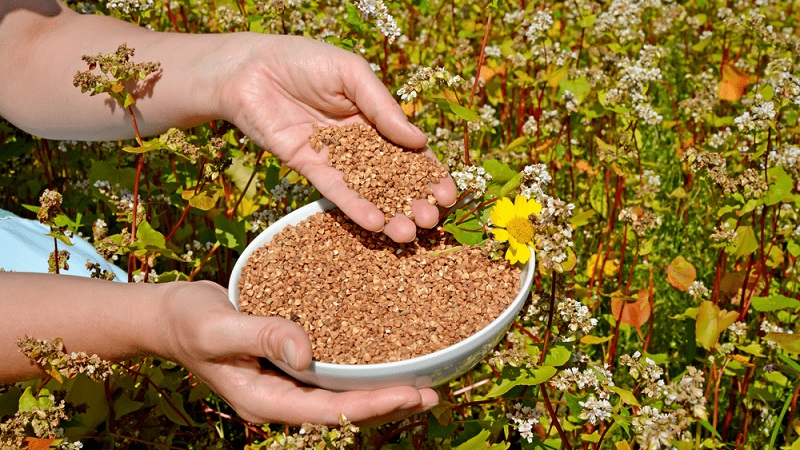How to sow buckwheat in the Kemerovo region: optimal timing and seeding rates
Sowing buckwheat is a valuable plant that is used in many areas of production. From the fruit, a kernel is obtained, and Smolensk groats are made. Leaves and flowers are used medicinally. Buckwheat is the main honey plant in many regions of Russia. Straw and grain waste are not thrown away, but used as feed for pets. The husk is processed into potash. Let's figure out how to sow a crop in the Kemerovo region correctly so that it gives a large and useful harvest.
The content of the article
Sowing dates for buckwheat in the Kemerovo region

Of the total number of ripe flowers, only 15% give valuable grain. In this regard, determining the sowing date is a very important point. It is important to choose it so that the stage flowering did not coincide with drought, and grain sprouting occurred in winter.
Reference.Buckwheat - light-loving plant. Sunlight is one of the key factors contributing to crop yields. In dark areas, the plant develops more slowly, reduces the number of inflorescences and consumes less carbon dioxide.
In the Kemerovo region, buckwheat is sown in 2 terms. If spring is warm and early, the ideal time for sowing is the third decade of May. During this period, rowan blossoms and fluffy white dandelion heads appear. If the spring is late and cold, sowing is best done from 1 to 10 June. At this time, ears of winter rye appear and viburnum blooms. It is important to consider these factors in order to get a high yield of buckwheat.
Seeding rate
Seeding rates vary over a wide range. Their increase does not in any way affect the growth of yield. At low rates, the plant turns out to be the strongest and healthiest, at large rates it develops poorly and gives a small yield. Indicators also depend on the climatic zone. For the Kemerovo region, the norms are:
- at sowing in one row - 70–90 kg per 1 ha;
- with wide-row sowing - 50-60 kg per 1 ha.
On small plots, it is best to sow buckwheat in wide rows. There should be 50 cm of space between them. For row sowing, the row spacing is 15 cm.
How to sow buckwheat in a vegetable garden or garden plot
The plant belongs to green manure, therefore it increases the fertility of any soil. Because of its beautiful flowering, buckwheat is used in landscape design.

Soil preparation
Ideal conditions for buckwheat are lit areas that are protected from dry winds. Loamy or sandy loam soil is suitable for culture. The optimum pH is 5–7.5. If the soil is highly acidic, slaked lime (0.5 kg per 1 m²) is added to it. In the fall, the site is plowed or dug up, phosphorus and potash fertilizers must be applied. To ripen 100 kg of grain, a plant needs 2–4 kg of phosphorus and 5–6 kg of potassium.
Reference. An ideal soil moisturizer would be a barrier that traps snow. It is constructed from any materials.
In the spring, the top layer of the soil is loosened, nitrogen fertilizers are applied (3-5 kg per 1 centner of grain). Digging is required only if the ground is very compacted or there is too much moisture in it.
Selection and preparation of seeds
To obtain a high-quality harvest, the area in which the buckwheat will be grow up... All plant varieties are suitable for the Kemerovo region, because it is not prone to droughts.
It is important to prepare the seeds before sowing:
- select only large and heavy specimens;
- treat with fungicides ("Vintsit", "Vitavax" and "Quinto Duo") to protect plants from fungi and bacteria;
- treat with micronutrient fertilizers that contain molybdenum ammonium or boric acid;
- 5 days before sowing, heat by air-heat method (sprinkle the seeds on a dry surface in a lighted dry place and mix them periodically).
If you strictly follow all the points, the chances of a good harvest will increase significantly.
Landing scheme
How to plant buckwheat in the garden depending on the quality of the land:
- If the soil is depleted in minerals and there are no weeds, sowing is done at a distance of 7.5-15 cm between rows.
- If the soil is fertile enough, many weeds grow on it, up to 45 cm is left between the rows. Such a gap allows you to cultivate the site, which, in turn, contributes to an increase in yield.
The planting depth of seeds depends on the type of soil. If it is heavy and often swims, the seeds are buried 3-5 cm; if loose and dry - by 5–8 cm. After all the seeds are planted, water the entire area abundantly, add dropwise and level.
5 days after sowing, furrows are made across or diagonally to the seed. This helps to remove the crust that forms from irrigation and helps draw moisture to the seed. As a result, seedlings will appear faster, buckwheat will develop evenly.
Crop care

If all the rules of sowing are observed, buckwheat emerges in about a week, and after 6 days the first leaves will grow. It is very important to water the plants during this period. Soil moisture is maintained within 70–80%. Water consumption is 350-450 m³ per hectare.
Fertilizers and feeding
Buckwheat is very fond of fertilizers. The best effect on plants is phosphorus-potassium fertilization, but they act differently on different types of soil:
- phosphorus fertilizers are suitable for black soil;
- for podzolic, gray and leached chernozems, nitrogen and phosphorus compositions are ideal.
The bulk of fertilizers are applied in the fall:
- for chernozem - 300–500 kg per 1 ha of phosphate rock or 150–200 kg per 1 ha of superphosphate;
- for podzolic, gray and leached chernozems - 400–600 kg per 1 ha of phosphorite flour, 300–500 kg per 1 ha of ash, or 100–150 kg per 1 ha of potassium salt;
- for loamy and sandy loam soil - mineral fertilizers: N (45 kg per 1 ha), P2O5 (60 kg per 1 ha), K2O (60 kg per 1 ha);
- for depleted soil, together with mineral fertilizing, manure or compost from peat and manure is used - 15–20 tons per hectare.
For buckwheat, all organic fertilizers are applied exclusively in the form of compost.
Mineral dressing is used in the spring, at the stage of cultivation. Granular superphosphate in the amount of 50–70 kg per hectare is well suited.
Advice! To increase yields, micronutrient fertilizers are used. The most effective among them are boron-based. They are applied simultaneously with other types of feeding in the amount of 50-60 kg per 1 ha.
During the flowering period, buckwheat needs nutrients most of all. At this stage, fertilization with ammonium nitrate (60–80 kg per 1 ha) is best suited. Together with it, superphosphate is used (100-150 kg per 1 ha). Means are buried to a depth of 8-10 cm at a distance of 10 cm from the rows with plants. The use of phosphorus-nitrogen compounds increases the amount of nectar that is produced in flowers. As a result, insect pollination is improved, and the yield increases.
Weed control
The most effective method of protecting buckwheat from weeds is the use of chemicals. In autumn, continuous action herbicides are used, which help to remove perennial weeds:
- from the thistle of the field, sow thistle, creeping wheatgrass - "Glyfogan", "Hurricane Forte" or "Roundup";
- against annual dicotyledonous weeds - "Desormon" or "Gezagard";
- for breeding highlander bindweed and odorless chamomile - "Butizan 400".
- for elimination of cereal weeds - 2,4-D amine salt (4 kg per 1 ha).
Be sure to observe the dosage of herbicides for a particular type of soil.Otherwise, they will destroy the buckwheat itself.
Harvesting in the Kemerovo region
Establishing exact calendar dates is impossible. Roughly the collection falls on August - September. The main sign of ripeness is darkening of more than 75% of the grain.

Timing
Buckwheat ripens for a long time - 25–35 days after the beginning of flowering. If the weather is humid, ripening is delayed. In drought conditions, the fruits stop growing completely until the moisture level rises. Grain harvesting begins at the moment when 2/3 become brown.
How to collect correctly
Full ripening of all plants is unacceptable, otherwise the best first shoots will crumble. It is advisable to harvest by a separate method:
- Mow the rows with the header or manually.
- Dry the grain and let it ripen in rolls.
- A few days after mowing, thresh with a combine or thresher.
The cutting height during mowing should be between 15–20 cm. This allows the swaths to dry completely.
When harvesting buckwheat from the oblique rolls are left to lie for a day. After they are tied with sheaves of no more than 50 cm in girth, they are laid in heaps of 4 sheaves for each. In this case, it is recommended to move the stems apart at the base to give more stability to the shock.
Threshing is also done manually. To do this, the top of the sheaf is placed in a bag and tapped with a strong stick on it using force.
Optimal dates for sowing buckwheat in Mordovia
Unlike the Kemerovo region, Mordovia is located in the west of Russia. The optimal time for sowing buckwheat in this region is the end of May, when the soil warms up to + 12 ... + 15 ° C at a depth of 8–10 cm. These are ideal conditions for planting a crop.
Many people consider buckwheat to be a capricious plant, which is difficult to care for because of its heat and moisture content. It is quite possible to grow culture both in Mordovia and in the Kemerovo region. This is facilitated by the climatic location of the regions. The average monthly rainfall is 50–70 mm, the average temperature is + 17… + 18 ° C, which is favorable for the plant.
Conclusion
Buckwheat grows on almost any type of soil. It is grown not only in large fields, but also in vegetable gardens or garden plots. It is important to observe the sowing time, properly feed the crop and care for it. If all the requirements are met, the plant will definitely please with a good harvest.